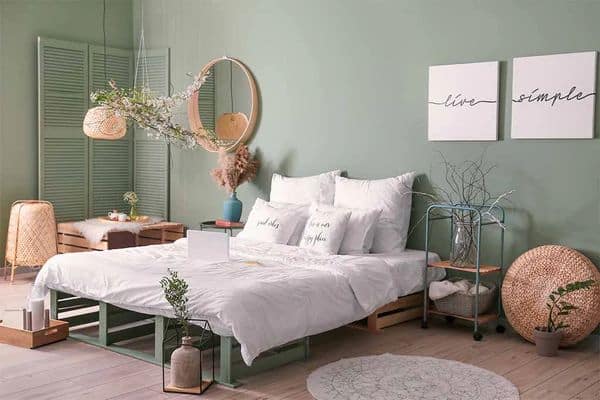Choosing the right color for a bedroom light is an important decision when creating a relaxing space. The color of light in a bedroom can affect sleep quality, mood, and ambiance. When selecting bedroom lighting, it’s important to consider how color impacts relaxation, sleep, and health. This article will examine the best bedroom light colors for relaxation, provide color recommendations, and outline lighting tips for maximizing comfort in the bedroom.
How Lighting Color Affects Relaxation and Sleep
Light color and temperature can significantly influence relaxation, sleep quality, and health. Here’s an overview of how different colors impact bedrooms:
Warm White (2700K-3000K): Warm white light is relaxing and cozy. The subtle yellow hue resembles incandescent lighting and promotes comfort and relaxation. Warm white is ideal for bedrooms since it won’t suppress melatonin production.
Soft White (3000K-4000K): With a brighter, whiter cast than warm white, soft white is commonly used in bedrooms. It provides ambient lighting that is relaxing but more energizing than warm white. Soft white supports focus while still being soothing.
Bright White (3500K-4100K): Bright white light has a crisper, bluer tone. It’s energizing and ideal for task lighting. But it can be disruptive for sleep when used as an overall bedroom light. Bright white light at night can reduce melatonin.
Cool White (4100K-5000K): Cool white light mimics daylight and has a blue/white glow. While it’s energizing for daytime, it can hinder relaxation and sleep at night. Prolonged exposure to cool white light before bed can impair sleep quality.
Natural Daylight: Exposure to natural daylight during the day helps regulate melatonin production and circadian rhythms. Limiting blue light exposure from screens and cool white lights in the evening lets the body know it’s time for sleep.
Best Bedroom Light Colors for Relaxation
The most relaxing colors for bedroom lights are:
Warm White: The warm glow of a warm white bulb is the most relaxing option for a primary bedroom light. The yellowish hue feels cocooning and comfortable without being overly dim. Warm white is flattering and promotes tranquility.
Soft White: For those who prefer a brighter ambient light, soft white strikes the perfect balance between energizing and soothing. The clean white tone with a hint of warmth is ideal for bedrooms.
Off-White: Off-whites like beige, ivory, or cream produce an understated, neutral glow. The soft tone isn’t stark like bright white so it’s ideal for relaxation. Pair an off-white lamp with warm white overhead lighting.
Yellow: Pure yellow light conjures feelings of optimism and creativity. For bedrooms, golden yellow light provides a soothing ambiance perfect for unwinding and de-stressing. Yellow is a great accent color.
Peach: The warm pinkish glow of peach is soothing and romantic. Peach-toned lighting helps release stress and anxiety before bed. Using peach accent lamps or wall sconces can make a bedroom more tranquil.
Color Recommendations for Bedroom Lighting
Here are the best practices for using color to make your bedroom a relaxing oasis:
Use warm white for general lighting: Install warm white light bulbs (2700K-3000K) in overhead bedroom lights and lamps. Warm white is relaxing enough for evenings but bright enough for dressing.
Incorporate accent lighting: Add lamps with soft white or amber bulbs on each nightstand and in sitting areas. Local accent lighting prevents the room from feeling too shadowy while allowing individual control.
Consider color-changing bulbs: Smart bulbs like Philips Hue can change color temperature and dimness. Program them to turn soft white in the evening for relaxation then bright white in the morning to energize.
Use wall sconces: Install peach, amber, or gold wall sconces beside the bed or by a reading nook. Cozy lighting from the side walls makes the room feel more enclosed.
Highlight decor: Use accent lights, picture lights, or LED strips to illuminate artwork, architectural elements, shelves, and plants. Interesting shadows create depth and visual warmth.
Lighting Tips for Maximizing Relaxation in the Bedroom
Beyond selecting the right bulb color, there are other lighting strategies that can make a bedroom more relaxing and sleep-friendly:
Install dimmers: Dimming overhead and bedside lights allows you to control brightness for various activities and times of day.
Use multiple lighting layers: Combine overhead, lamp, accent, and decorative lighting to create a warm ambiance. Varying light levels prevents harshness.
Organize by function: Use bright, focused task lighting at vanities and sitting areas. Reserve ambient and mood lighting for general illumination.
Minimize blue light: Swap out any cool white bulbs and avoid bright blue overhead lighting. Blue wavelengths suppress melatonin.
Limit night lights: While some night light is good for safety, too much can disrupt sleep. Keep it dim and warm toned.
Install dimmer switches: Dimmers allow you to easily control the light level in the bedroom for maximum comfort and relaxation.
Use indirect lighting: Bounce light off the ceiling or walls to reduce glare. Soft, diffuse lighting prevents harsh shadows.
Add lighting zones: Separate lighting into zones for the bed, sitting area, and vanity. Individual controls let you customize each area.
Conclusion
The right lighting color and design can make a bedroom much more relaxing and peaceful. The best colors for promoting relaxation and sleep are warm white, soft white, amber, peach, and yellow. Maximize comfort through layers of light, dimmers, accent lighting, and avoiding blue wavelengths in the evening. Thoughtful bedroom lighting results in a rejuvenating space that facilitates deeper rest.


